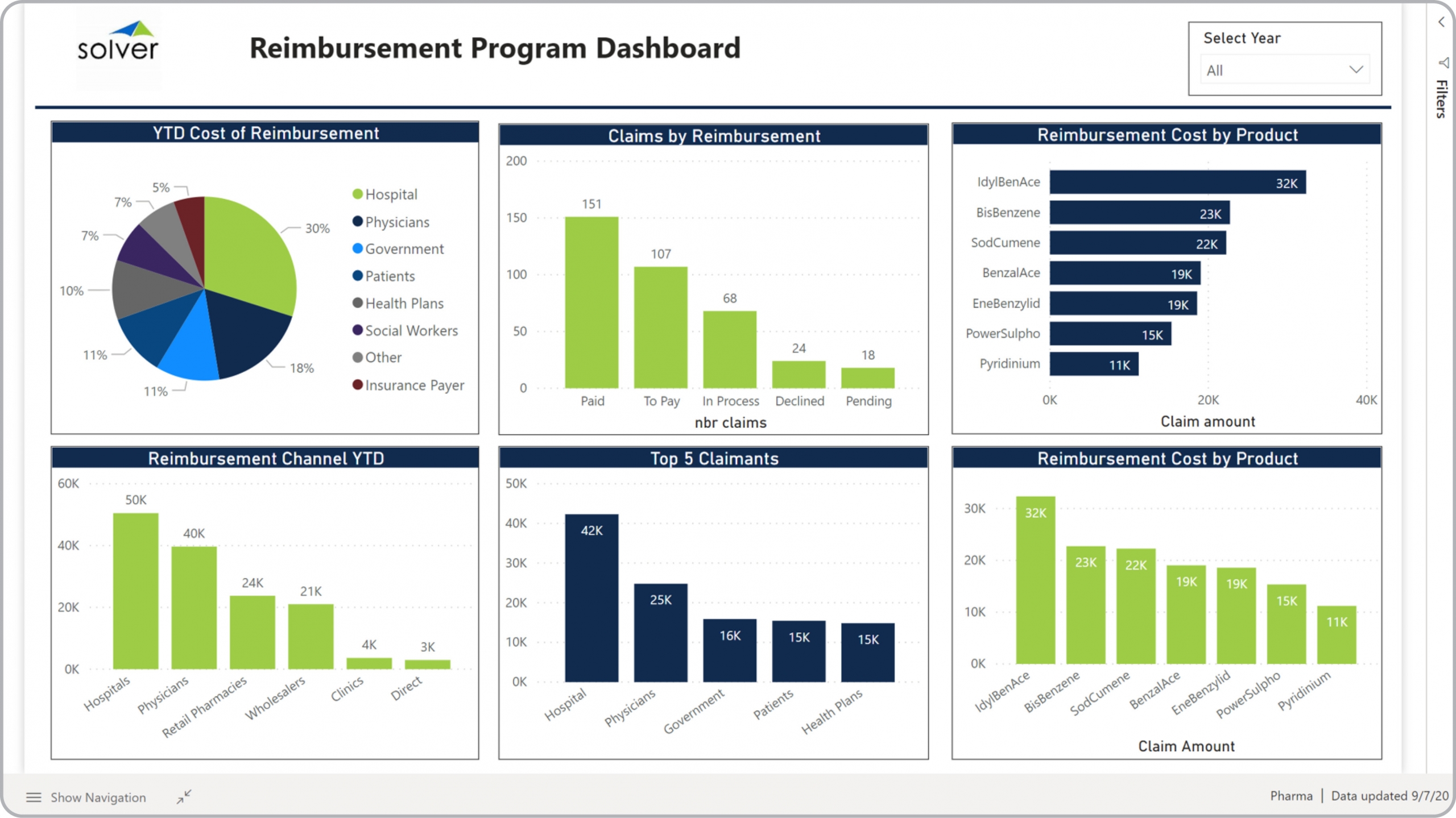Reimbursement Program Dashboard for Pharmaceutical Companies
What is a
Reimbursement Program Dashboard
? Reimbursement Program Dashboards are considered patient assistance analysis tools and are used by Program Managers to monitor KPIs in their programs. Some of the main functionality in this type of dashboard is that it provides graphical insights from six different perspectives: 1) Year to date cost of reimbursements, 2) Claims by reimbursement status, 3) Reimbursement cost by product, 4) Year to date reimbursement by channel, 5) Top 5 claimants, and 6) Reimbursement cost by product. You find an example of this type of dashboard below.
Purpose of
Reimbursement Program Dashboards Pharmaceutical companies use Reimbursement Program Dashboards to give managers quick insights into metrics and trends in their patient assistance programs. When used as part of good business practices in Financial Planning & Analysis (FP&A) and Reimbursement departments, an organization can improve its reimbursement strategies and strengthen financial outcomes, and it can reduce the chances that it takes too much time to detect and adjust inefficient programs.
Example of a
Reimbursement Program Dashboard Here is an example of a Reimbursement Program Dashboard with cost and claim analysis. [caption id="" align="alignnone" width="2560"]
 Example of a Reimbursement Program Dashboard for Pharmaceutical Companies[/caption] You can find hundreds of additional examples
here
Who Uses This Type of
Dashboard
? The typical users of this type of dashboard are: Reimbursement program managers, executives, product managers, patience assistance managers.
Other Reports Often Used in Conjunction with
Reimbursement Program Dashboards Progressive Financial Planning & Analysis (FP&A) and Reimbursement departments sometimes use several different Reimbursement Program Dashboards, along with profit & loss reports, annual budgets, sales forecasts, detailed reimbursement reports, expense dashboards, KPI dashboards and other management and control tools.
Where Does the Data for Analysis Originate From? The Actual (historical transactions) data typically comes from enterprise resource planning (ERP) systems like: Microsoft Dynamics 365 (D365) Finance, Microsoft Dynamics 365 Business Central (D365 BC), Microsoft Dynamics AX, Microsoft Dynamics NAV, Microsoft Dynamics GP, Microsoft Dynamics SL, Sage Intacct, Sage 100, Sage 300, Sage 500, Sage X3, SAP Business One, SAP ByDesign, Acumatica, Netsuite and others. In analyses where budgets or forecasts are used, the planning data most often originates from in-house Excel spreadsheet models or from professional corporate performance management (CPM/EPM) solutions.
What Tools are Typically used for Reporting, Planning and Dashboards? Examples of business software used with the data and ERPs mentioned above are:
Example of a Reimbursement Program Dashboard for Pharmaceutical Companies[/caption] You can find hundreds of additional examples
here
Who Uses This Type of
Dashboard
? The typical users of this type of dashboard are: Reimbursement program managers, executives, product managers, patience assistance managers.
Other Reports Often Used in Conjunction with
Reimbursement Program Dashboards Progressive Financial Planning & Analysis (FP&A) and Reimbursement departments sometimes use several different Reimbursement Program Dashboards, along with profit & loss reports, annual budgets, sales forecasts, detailed reimbursement reports, expense dashboards, KPI dashboards and other management and control tools.
Where Does the Data for Analysis Originate From? The Actual (historical transactions) data typically comes from enterprise resource planning (ERP) systems like: Microsoft Dynamics 365 (D365) Finance, Microsoft Dynamics 365 Business Central (D365 BC), Microsoft Dynamics AX, Microsoft Dynamics NAV, Microsoft Dynamics GP, Microsoft Dynamics SL, Sage Intacct, Sage 100, Sage 300, Sage 500, Sage X3, SAP Business One, SAP ByDesign, Acumatica, Netsuite and others. In analyses where budgets or forecasts are used, the planning data most often originates from in-house Excel spreadsheet models or from professional corporate performance management (CPM/EPM) solutions.
What Tools are Typically used for Reporting, Planning and Dashboards? Examples of business software used with the data and ERPs mentioned above are:
- Native ERP report writers and query tools
- Spreadsheets (for example Microsoft Excel)
- Corporate Performance Management (CPM) tools (for example Solver)
- Dashboards (for example Microsoft Power BI and Tableau)
Corporate Performance Management (CPM) Cloud Solutions and More Examples
April 29, 2021
TAGS:
Reporting,
Solver,
report writer,
Microsoft,
template,
practice,
Acumatica,
visualization,
Netsuite,
Finance,
planning,
GP,
dashboard,
pharmaceutical,
Business Central,
excel,
ax,
claims,
forecast,
Budget,
cost,
Dynamics 365,
budgeting,
pharma dashboard,
KPI,
Cloud,
Software,
channel,
product,
Tableau,
SAP,
example,
best,
Sage,
BC,
D365,
NAV,
Intacct,
pharma,
CPM,
report,
SL,
Management,
dynamics,
Power BI,
reimbursement,
reimbursement dashboard,
patient assistance program

